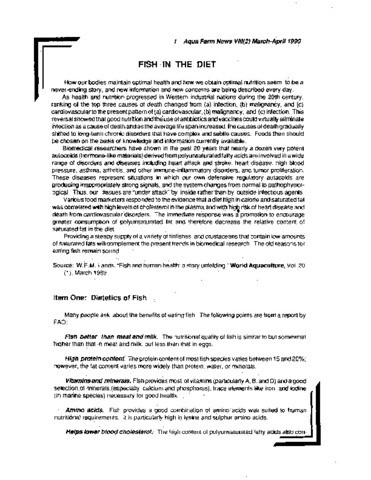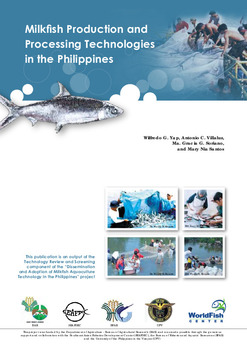Handling and processing of tilapia
| dc.contributor.author | Guevara, Gloria | |
| dc.contributor.editor | Guerrero III, Rafael D. | |
| dc.contributor.editor | de Guzman, Dalisay L. | |
| dc.contributor.editor | Lantican, Cecilia M. | |
| dc.date.accessioned | 2021-07-30T00:56:50Z | |
| dc.date.available | 2021-07-30T00:56:50Z | |
| dc.date.issued | 1987 | |
| dc.identifier.citation | Guevara, G. (1987). Handling and processing of tilapia. In R. D. Guerrero III, D. L. de Guzman, & C. M. Lantican (Eds.), Tilapia Farming: Proceedings of the First National Symposium and Workshop on Tilapia Farming, PCARRD, Los Baños, Laguna, November 24-26, 1986 (pp. 43-47). Philippine Council for Agriculture, Forestry and Natural Resources Research and Development. | en |
| dc.identifier.uri | http://hdl.handle.net/10862/6167 | |
| dc.description.abstract | Tilapia is a very promising aquaculture species with the development of the aquaculture industry. The commercial value of tilapia varies greatly with size in certain countries like Israel and Africa. In Southeast Asia, size is not an important factor; the market price varies regionally. Although tilapia could compare favorably with other aquaculture products, its flesh being very high in quality, some consumers have a strong objection to its dark skin. Nonetheless, tilapia is currently one of the most important fish crops in most countries of the world. With the improvement of aquaculture technology, tilapia is now grown in fish cages, fishponds and other inland waters. There is no doubt that this has helped increase the production of the aquaculture sector to the total fish production by over 20% in 1983. The 1984 production of tilapia in fish cages was 7,070 kg; for inland fisheries, the production was 22,295 kg; and in fishponds, 10,508 kg. This gave a total value of P485,653 (BFAR Statistics 1981). With appropriate processing technology, tilapia can be manufactured into various products both for human consumption and as feed ingredients which will help increase its commercial value. Tilapia which are too small for human consumption should not be wasted. These can be converted into feed ingredients for livestock feeds or used as baits in commercial fishing. In developing countries like the Philippines where there is an immediate need for protein source, tilapia could be readily available due to subsistence and commercial-scale culture of this fish. | en |
| dc.language.iso | en | en |
| dc.publisher | Philippine Council for Agriculture, Forestry and Natural Resources Research and Development | en |
| dc.subject | tilapia | en |
| dc.title | Handling and processing of tilapia | en |
| dc.type | Conference paper | en |
| dc.citation.spage | 43 | en |
| dc.citation.epage | 47 | en |
| dc.citation.conferenceTitle | Tilapia Farming: Proceedings of the First National Symposium and Workshop on Tilapia Farming, PCARRD, Los Baños, Laguna, November 24-26, 1986 | en |
| dc.subject.asfa | fish handling | en |
| dc.subject.asfa | processing | en |
| dc.subject.asfa | drying | en |
| dc.subject.asfa | chemical analysis | en |
| dc.subject.asfa | curing (processing) | en |
| dc.subject.asfa | canning | en |
| dc.subject.asfa | fish meal processing | en |
このアイテムのファイル
| ファイル | サイズ | フォーマット | 閲覧 |
|---|---|---|---|
|
このアイテムに関連するファイルは存在しません。 |
|||
このアイテムは次のコレクションに所属しています
-
Tilapia Farming [9]
Proceedings of the First National Symposium and Workshop on Tilapia Farming, PCARRD, Los Baños, Laguna, November 24-26, 1986




